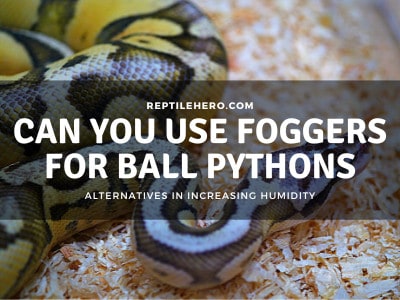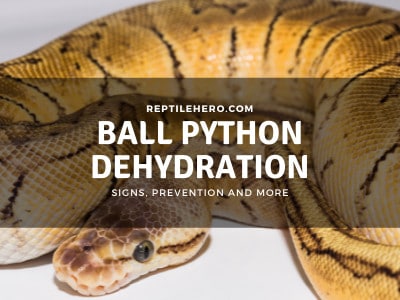Is Your Ball Python Trying to Escape? (Signs & Reasons)
Does your ball python show signs that it wants to escape? Or did it escape already? Even though their husbandry is optimized in captive keeping, why do ball pythons try to escape their enclosures?
Restless movements and pushing enclosure walls are signs that a ball python is trying to escape. Ball pythons try to escape as a way to explore their surroundings, temperature issues, humidity problems, dirty enclosure, lack of hides, and also temperament.
Ball pythons are active at night and are often seen exploring their enclosure. What are the reasons why they try to escape? What should you do during, and after a ball python escapes? Find out more as you read down below!
2 Signs of a Ball Python Trying to Escape
In general, there are 2 major signs to look out for when a ball python is trying to escape: 1) pushing and 2) restlessness.
1. Pushing
Ball pythons that push themselves against the sides of their enclosure might mean that they want to escape. A ball python constantly pushing the walls and top of an enclosure might need urgent attention.
If a ball python frequently pushes the sides and top of an enclosure, this can mean that they are uncomfortable due to certain issues like temperature, humidity, sanitation, or lack of hides.
I suggest immediately checking all husbandry parameters or adding hiding spots when ball pythons are seen pushing the enclosure walls.
Excessive pushing can also cause minor injuries to a ball python’s nose or mouth, especially if they push against metal screens typically located at the top of an enclosure.
2. Restlessness
If a ball python keeps moving fast around its enclosure, then it might be a sign that it wants to escape. Ball pythons that are seen to be restless are typically stressed due to temperature and humidity problems.
Ball pythons will always seek the optimal spot for their current needs and this can mean outside the enclosure.
For example, ball pythons situated in high ambient heat with no place to cool off can be seen pacing side to side in an enclosure desperately seeking an area with the right temperature.
When ball pythons explore their enclosures, they do it in a slow and calm manner. If their movements become faster, then they might be having certain husbandry problems.
I recommend double checking their humidity, temperature, and wastes inside the enclosure.
6 Reasons Why Ball Pythons are Trying to Escape
In total, there are 8 reasons why a ball python may try escaping its enclosure. These are: 1) exploring, 2) temperature, 3) humidity, 4) dirty enclosure, 5) lack of hides, and 6) temperament.
1. Exploring
The most common reason why a ball python is trying to escape is due to its urge to explore. Factors that may cause exploring are: 1) time, 2) new enclosure, 3) hunger, and 4) breeding season.
1. Time
Overall, ball pythons can either be crepuscular or nocturnal animals. This means they are active during dawn, dusk, and night. During these times, they are frequently seen exploring inside the enclosure and sometimes wanting to escape.
During either dawn, dusk, or night, temperatures naturally drop, and sometimes a ball python may want to escape because it is too cold inside the enclosure.
Fun Fact: Ball pythons are equipped with heat-sensing pit organs which are located in their nose area. This helps them to hunt prey in the dark.
2. New Enclosure
Some ball pythons that are placed in a new environment tend to be stressed which makes them want to escape the enclosure.
Such instances happen if a snake is newly-acquired or if the enclosure is newly cleaned. Upgrading into a bigger enclosure can also overwhelm some ball pythons which will also urge them to escape.
Conversely, there are also some that typically explore calmly and familiarize themselves with the surroundings. This means that their response will also depend on innate temperament.
3. Hunger
Ball pythons that are hungry, can often be seen slithering inside an enclosure in search of food. If they cannot find any food inside, then they will start to find a way out of the enclosure to look for one.
Fun Fact: Ball pythons in the wild seek out prey in burrows or even in trees [1]. Most of the time they are seen invading a rodent’s nest under the ground which they will use for shelter or egg-laying.
One method to know whether or not a ball python is searching for food is to place your palm near the enclosure. Your snake might be hungry if it is receptive to your hand’s movements and goes into a striking position.
Warning: While doing this test, I suggest doing it as quickly as you can so the ball python would not strike the walls of the enclosure. Cage striking can cause injuries to their mouth and nose.
>> Learn more about feeders in our article on feeding mice and rats to a ball python.
4. Breeding Season
During the breeding season, adult ball pythons are triggered by temperature drops which urge them to escape the enclosure they are in and find a partner.
So if you keep multiple ball pythons in a room, mature females will release pheromones which will attract mature males [2]. As a result, adults (mostly males) will tend to push the enclosure to escape and search for a potential female.
The breeding season of ball pythons is around September and November.
2. Temperature
If the temperature range is not suitable for ball pythons, it may urge them to try to escape the enclosure. The recommended temperature gradient for ball pythons is around 75-90°F.
Ball pythons that have agitated movements can be looking for a hot spot or cold spot to battle an excessive temperature. If this happens, they will find a way to escape from the uncomfortable situation they are in.
Some keepers share their experiences regarding unregulated heating devices which cause overheating and malfunctions. Ball pythons in this situation tend to stay far away from the heat source and push the walls of the enclosure, which depicts escaping.
You can use heating devices such as heat lamps, ceramic heat emitters, deep heat projectors, and heat mats.
3. Humidity
Ball pythons often phase back and forth if the humidity level is not right especially when they are about to shed. They will be urged to escape if the moisture parameters are not met for shedding or when they feel dehydrated.
Low humidity can cause respiratory infections and dehydration while high humidity can increase bacterial growth. If ball pythons become infected or dehydrated, they would want to go out of the enclosure or show signs of stress.
Ball pythons need humidity for shedding, digestion, and hydration.
The recommended humidity levels should be at 50-70% while 80% when the snake is about to shed. To increase the humidity of the enclosure, you can: decrease ventilation, provide a large water dish, use humidifiers, misting, and provide a humidity box.
>> Learn more about maintaining humidity levels in our article about foggers and misters for ball pythons
4. Dirty Enclosure
Most of the time, an unclean enclosure can lead to ball pythons trying to escape for them to be in a cleaner environment. Hence, it is recommended to monitor defecation every day and immediately spot clean if there are wastes.
For spot cleaning, I suggest removing the substrate around the waste and replacing their water as both may contain urine. Substrates must also be replaced once or twice a month.
For monthly deep cleaning, I recommend using F10 or a veterinary-safe cleaning agent. Make sure to check for strong chemical smells after the enclosure has been cleaned.
When their tanks are kept fresh and clean, your ball python will no longer have any need to escape its pristine home!
Fun Fact: In the wild, ball pythons are often found in rodent burrows and termite hides [3]. They are also observed leaving these hiding places when it is full of their feces or when they have hatched and tended to their eggs [4].
5. Lack of Hides
Lack of hiding places can also cause ball pythons to escape their enclosures. Mostly in transparent enclosures, ball pythons will feel stressed if they are exposed in the open without any options for hiding.
Besides exposure, some ball pythons would not feel secure when they have no tight space to wedge in. If they do not feel secure, ball pythons will find another place which provokes them to escape.
When choosing a hide for a ball python, it is important to check for sharp edges to avoid scale damage and other injuries. You can also sand edges down with sandpaper, file, or Dremel.
>> Learn more about choosing the right in our article about do ball pythons always hide?
To add additional hiding spots, I recommend adding clutter like cork barks, branches, live/ artificial plants, and other foliage.
6. Temperament
Each ball python will have different temperaments which can affect factors leading to escaping an enclosure. Each has different levels of tolerance to smell, handling, and other factors that lead to stress.
Some ball pythons are sensitive while some can tolerate stress compared to others. Those that are sensitive to stress and exposure will tend to escape if not provided with proper hiding spots.
When a ball python is born with a bold and outgoing temperament then you can see it scoping the enclosure and trying to get out to explore.
In relation to this, there are also some ball pythons that do not seem to mind being near its feces but there are some who want to escape when exposed to its smell.
Increasing the level of tolerance of ball pythons to being handled can cause them to be easier to deal with and help them differentiate between feeding and handling time.
2 Things to Prevent Ball Python From Escaping
Ball pythons can be stopped from escaping by keeping in mind 2 things: 1) locks and 2) enclosure.
1. Locks
It is recommended to have some form of lock to prevent the ball python from escaping its enclosure.
For sliding doors, sliding glass locks are recommended. It is also what I personally use in the enclosure of Choco, my adult male ball python.

If a swing-type door is used, I recommend barren bolts and swing arm clasps.

For top-opening enclosures, I recommend using at least 4 Pieces of metal cage lock clips in securing the lid. Conversely, I discourage using heavy objects as a way to secure the lid of an enclosure.
Some opt to use heavy objects like books and rocks that might seem impossible for a ball python to push. But with enough leverage, it might be able to slide past through a small opening which can cause injuries when the lid closes back.
Fun Fact: Ball pythons are strong constrictors capable of constricting 8.7 psi which incapacitates prey [5].
I also discourage using magnets as the primary lock as it can easily be opened by a strong snake like a ball python, letting itself effortlessly escape.
2. Enclosure Design
For ball pythons under 500 grams, it is not recommended to use sliding-door type enclosures. Ball pythons smaller than this size can get stuck on the tracks and in between the glass panel.
Ball python enclosures that have built-in holes for wires or ventilation can also be an escape path for a small-sized ball python.
Bigger-sized ball pythons (yearlings to adults) will have more strength which means that they can power through enclosure doors.
Big ball pythons can push to open up these kinds of enclosures which is why a cage lock is optimal to prevent escaping. Sliding or swing-type doors, ball pythons can find a way to open it so it is required to have a secured lock.
In my personal experience, my ball python Choco escaped from his sliding glass enclosure which has no lock. I think I accidentally left a slight opening and he took the chance to open it and escape afterward.
After this, I immediately bought him a sliding door lock and he never escaped ever since.
Fun Fact: Ball pythons (except overweight ones) can fit through a hole slightly bigger than the size of their head.
7 Ways to Find an Escaped Ball Python
To have a higher chance of finding a ball python that has recently escaped, It is recommended to follow the procedures:
- Double-check the enclosure.
- Relocate other pets.
- Flip furniture.
- Check holes/cracks.
- Track with flour.
- Offer hide and pre-killed feeder.
- Continue waiting.
Read till the end to discover the finer details to keep in mind when looking for a ball python that has escaped!
1. Double-Check the Enclosure
Check all the hollow parts of the enclosure like hides, water bowls, fake rocks, and backgrounds.
2. Relocate Other Pets
Immediately after finding out that the ball python escaped, it is recommended to put other pets like cats or dogs into a temporary room/ cage to prevent them from harming the snake.
3. Flip Furniture
Starting with the closest vicinity, it is advisable to flip or look through all furniture and clutter from the floor where your ball python has escaped.
They typically look for dark and warm places to hide, for example, under a fridge.
Pro Tip: Ball pythons typically follow walls when they have escaped from their enclosure. I suggest looking for potential hiding places closest to the wall.
4. Check Holes/Cracks
Check all exposed pipes, tubing, and cracks on the wall. I have found my ball python twice in this scenario, one from a crack in the wall and the other at a washing machine pipe.
5. Track With Flour
If you have not found the ball python within a day, I suggest spreading flour near the vicinity of the enclosure and in potential hiding places. They will make tracks if they have slithered across a powdered area.
6. Offering Hide and Pre-killed Feeder
As a last-ditch effort, you can try to place one or more hides in dark areas with a heat mat under them. Leaving a pre-killed prey overnight can also attract the ball python.
You can do this once or twice a week just make sure to remove the unconsumed prey after one night to avoid having a rotten smell.
7. Continue Waiting
If the procedures above did not work, then I suggest waiting and just hoping for the best. There are chances that ball pythons would not go out of the house and will eventually show up.
Based on my experience, I have waited for 3 days on choco’s first escape while 2 weeks for his second and last escape.
What to Do When You Find Your Escaped Ball Python (5 Things!)
If an escaped ball python is found, it is recommended to follow the following procedure:
1. Safely Coax it Out.
You can use water from a hose if it is stuck in a pipe or a crack in the wall. If the ball python still does not come out then you must wait and it will eventually come out when left alone.
For his first escape, I waited for an hour before choco left the crack in the wall. I was not able to coax him out because I don’t want to damage his scales.
2. Give a Warm Bath.
Give an escaped ball python a warm bath (80-85°F) to wash out dust, debris, and some external parasites. The duration must be around 10-15 minutes and can be done inside a plastic bin with a few ventilation holes.
It is also recommended to use purified or dechlorinated spring water because most probably, the ball python will rehydrate by drinking in the warm bath.
3. Check for Damages/ Illnesses
Check for missing scales, bruises, stuck shed, and mites. Then check for possible respiratory infections and mouth rot, if there are any, it is recommended to consult a veterinarian.
Dehydrated/ malnourished ball pythons are also recommended to bring to a veterinarian to avoid worsening their condition.
4. Quarantine
A newly found ball python must be placed in a temporary quarantine enclosure to avoid spreading diseases and parasites. Quarantine duration must be around 2-3 months.
5. Offer Food
Some keepers have a fair share of stories about ball pythons showing up after escaping many months prior. So if your snake is lost for a couple of weeks or months, I suggest giving it feeders to satiate its hunger.
Pro Tip: Recently found ball pythons must not be handled for a week unless for soaking, cleaning, and treatments. This will allow them to be comfortable again in their enclosures and will eventually eat food.
Further Questions
Do ball pythons like to explore?
Ball pythons like to explore at nighttime and hide under burrows and other hiding spots during daytime. They are nocturnal/ crepuscular which means they are most active during dusk, dawn, and night.
How do you know if a ball python escaped?
An escaped ball python can be confirmed by checking their hides, water dish, substrate, backgrounds, and other objects with hollow parts. An open enclosure is also a sign that they have escaped.
Is it normal for ball pythons to try to escape?
It is normal for a ball python to try to escape due to the lack of space they have in captivity. Even though husbandry parameters are optimized for captive-bred ball pythons, they do not experience the amount of roaming freedom that those in the wild encounter.
Summary of Ball Pythons Trying to Escape
Generally, there are 2 major signs to look out for when a ball python is trying to escape, which are restlessness and pushing.
In total, there are 8 reasons why a ball python is trying to escape its enclosure, these are exploring, temperature, humidity, dirty enclosure, lack of hides, and temperament. In regards to enclosure security, there are 2 things to keep in mind: type of locks and enclosure.
To find an escaped ball python, you should: double check enclosure, relocate other pets, flip through clutter and furniture, check holes and cracks, track using flour, offer hide and food, and wait patiently. Once the ball python is found, give it a warm bath and food then check its condition and put it in a temporary enclosure.
Resources
[1] https://www.tandfonline.com/doi/pdf/10.1080/11250009809386744
[2] https://digitalcommons.unl.edu/cgi/viewcontent.cgi?article=3298&context=icwdm_usdanwrc






